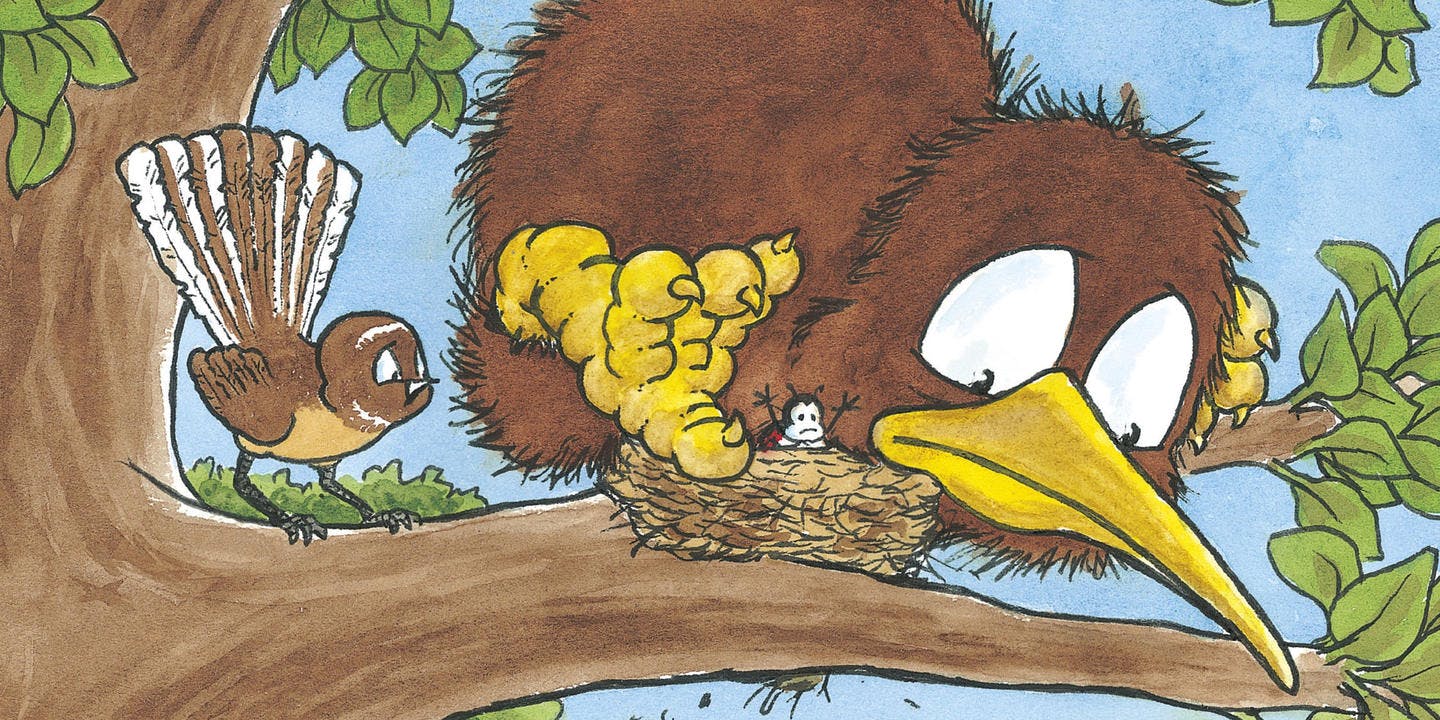Little Kiwi author and illustrator Bob Darroch answers our nosey questions.
1. You’ve been working for many years drawing and creating all sorts of wonderful artworks. Who or what inspired you to become an illustrator/cartoonist?
In the days before TV (there WAS a time), comics were our source of casual entertainment. While I enjoyed reading them, and trying my hand at copying some of the drawings (particularly those by the Disney Studios), I felt there would come a time when I would outgrow drawing cartoons. Most of what I’d seen were for kids – and I had high hopes of not being a kid forever. But in my early teens, I saw my first Carl Giles cartoon. A revelation! A cartoon that had all the elements that I admired, and it was for all ages! I was hooked, kept on scribbling, and didn’t care whether I was going to be a kid forever or not!
2. What made you write about kiwis? (Aside from how adorable they are, of course.)
My first thought about producing a kids’ book was to make it a New Zealand one. The most iconic characters I could think of were sheep and kiwis. I felt that there must be plenty of books about kiwis, so settled for a sheep story. It was accepted by Reeds, and after publishing they said, ‘Now do one about a kiwi’.
3. Originally your books in the series were called ‘the kiwi’ but were retitled to ‘Little Kiwi’. When did the character of Little Kiwi come out of his shell for you as a character?
It wasn’t really a conscious decision to have come out of his shell. (‘Come out of his shell’ – now THERE’S a good phrase!). I called him ‘the’ little kiwi for the first couple of books, but after naming a penguin ‘Little Blue’ in the second one, it seemed natural to name him ‘Little Kiwi’ from then on.
4. What is it you hope children take away from your stories?
Entertainment. Enjoyment. If they can learn from them, and maybe take an interest in the variety of birds (and other living things) we have in the New Zealand bush, so much the better. Hopefully they won’t expect the birds to talk to them.
5. Your Little Kiwi storylines often revolve around the unique animals and flora of New Zealand, besides of course just the kiwi. When you begin a Little Kiwi story, is education of NZ wildlife high on your list or does the plotting and setting of the stories naturally work them in?
I’ve aimed at keeping all the birds etc in their natural settings, away from human influences. Admittedly, we had some chooks in the second story, but apart from that, pure NZ bush. And scenery. It’s not necessarily planned that way. It’s just the way it is. So far...
6. Kiwis are unique in the world of birds. Actually they are really odd, now that we think about it. What’s the single weirdest aspect of kiwis do you think?
Kiwis are certainly weirdly unique. Or uniquely weird. It’s not just the nostril at the end of the beak, the hairlike feathers, and the mysterious stumps of wings, but producing an egg of that size in proportion to the body must bring water to the poor mum’s eyes!
7. There have been huge shifts in the illustration world thanks to digital processes, what is your illustrating process?
Digital process have revolutionised cartoon artwork. But that’s all over my head. I’ve only sussed out how a ball-point pen works. I still work with (and prefer) pen, ink and watercolours, but have yielded to modern technology by sometimes using felt-tip pens!
8. If you could invite five people (alive or dead) to dinner, who would they be and why?
Now there’s a dilemma! My first choices would be family members as they were before they scattered off in all directions. Or friends. We’ve had many a laugh, and solved many of the world’s problems, over the dining table! But of those that have inspired life-affecting decisions, I’d have to pay homage to Carl Giles, whose style of humour and drawing influenced my career. Also Carl Barks. I learned in life that it was his artwork that featured in the Disney comics I admired as a youngster. His accounts of life and work practices in the early years of the Disney Studios would interest me. As would talking to Sir David Attenborough. The information about the natural world that he has presented to us can only be described as ‘amazing’ – using a much-thrashed word in its original context. I’ve always greatly admired the humour and imagination of Spike Milligan and Eric Sykes. I can’t decide which one to choose, but as they have produced great work together, I’ll invite them both. Unfortunately, most of my guests are no longer with us. So Sir David and I might have to have our Big Macs in the cemetery.
9. What is your favourite book and why?
That’s as big a problem as choosing dinner guests. A favourite book would be somewhere between something humorous, and something educational. If Spike Milligan was David Attenborough and wrote a book, that might work. Or Giles and Charles Dickens. My first thought might be Puckoon by Spike Milligan, for its laugh-a-paragraph and imaginative descriptions of people and events. Or maybe Connections by James Burke. That came out a few years ago and traced the origin of things we might take for granted today, and how they came about through one invention leading to another, and another. Or something by Dickens. Ok, decision time... I’ll settle for Puckoon.
10. Where to next for our favourite little bird?
Little Kiwi is over 15 years old, which is getting on a bit for a bird. So maybe he and the author might start taking it easy. Maybe take up meditation. That should be better than sitting around doing nothing!












